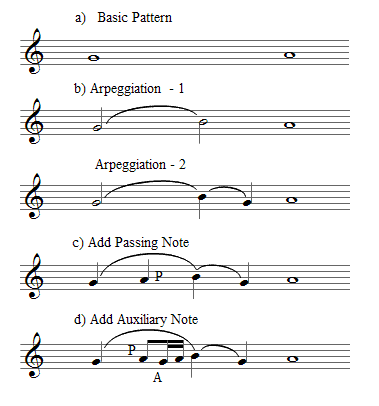APPENDIX A: VOICE LEADING OVERVIEW
Melodic Embellishment
By its very nature, counterpoint involves voices moving at different rates. However, this process shows a similarity with a musical process referred to as melodic embellishment or ornamentation. The idea is that a melodic pattern can be elaborated by replacing long notes by a number of shorter notes. In the 16th century, these were referred to as divisions or diminutions as the process of ornamentation is based on long notes being divided up into rhythmically smaller note lengths. Books of such ornamentations were produced for various instruments and had titles such as The Art of Playing Divisions.
The follow is an example from Sylvesto Ganassi Opera Intitulata Fontegara - A Treatise on the art of playing the Recorder and of Free Ornamentation (1535)

This first bar shows the simple melodic rising second pattern, followed by successively complex ways of elaborating on this pattern (1, 2, 3 etc). These embellishments always retain the underlying G - A pattern.
Just as in counterpoint, this process can be built in a series of layers. Following is the 5th embellishment of the same pattern above:

The following step by step construction shows how this pattern can be built in successive layers, using the basic transformations identified as the voice leading patterns discussed in earlier sections:

a) Is the basic pattern, a simple rising second, as shown above.
b) Arpeggiation - 1.
This is the first stage of elaboration (or division). The semibreve is divided equally into two minims by a movement of a consonant interval of a 3rd. This could be described as a consonant skip. Given that, in later music, it would have to fit in with an underlying harmony then it can alternatively be described as an arpeggiation based on notes of the underlying chord. The underlying harmony here could be a G major chord or an E minor chord or possibly some other chord, depending on the context.
Arpeggiation - 2
Next, a further division based on an arpeggiation back to the original note. Hence 1 and 2 combined, forms the first level of elaboration based on multiple arpeggiation of the first note as shown in b).
c) Add passing note
This is a second level of elaboration created by division of the first minim into two crotches by the addition of a passing note between the notes of the first arpeggiation. This passing note is dependent for its existence on the presence of the initial arpeggiation, therefore it can be said to be a new level of elaboration.
d) Add auxiliary note
This is a third level of elaboration created by the division of the second crotchet into a quaver and two semiquavers by the addition of an auxiliary note to the passing note. This auxiliary note is dependent for its existence on the presence of the passing note which is created at the previous level of elaboration.
This embellishment is thus based on three levels of transformation, each level depending on the presence of the previous level of transformation.
Even though this process involves only one line of melody, it can be seen that the transformations used for each level of elaboration are identical to the transformations used in creating counterpoint in two or more parts. This supports the idea that the basic contrapuntal transformations are fundamental to musical structure at least at the surface.
Next Topic: The Appoggiatura

